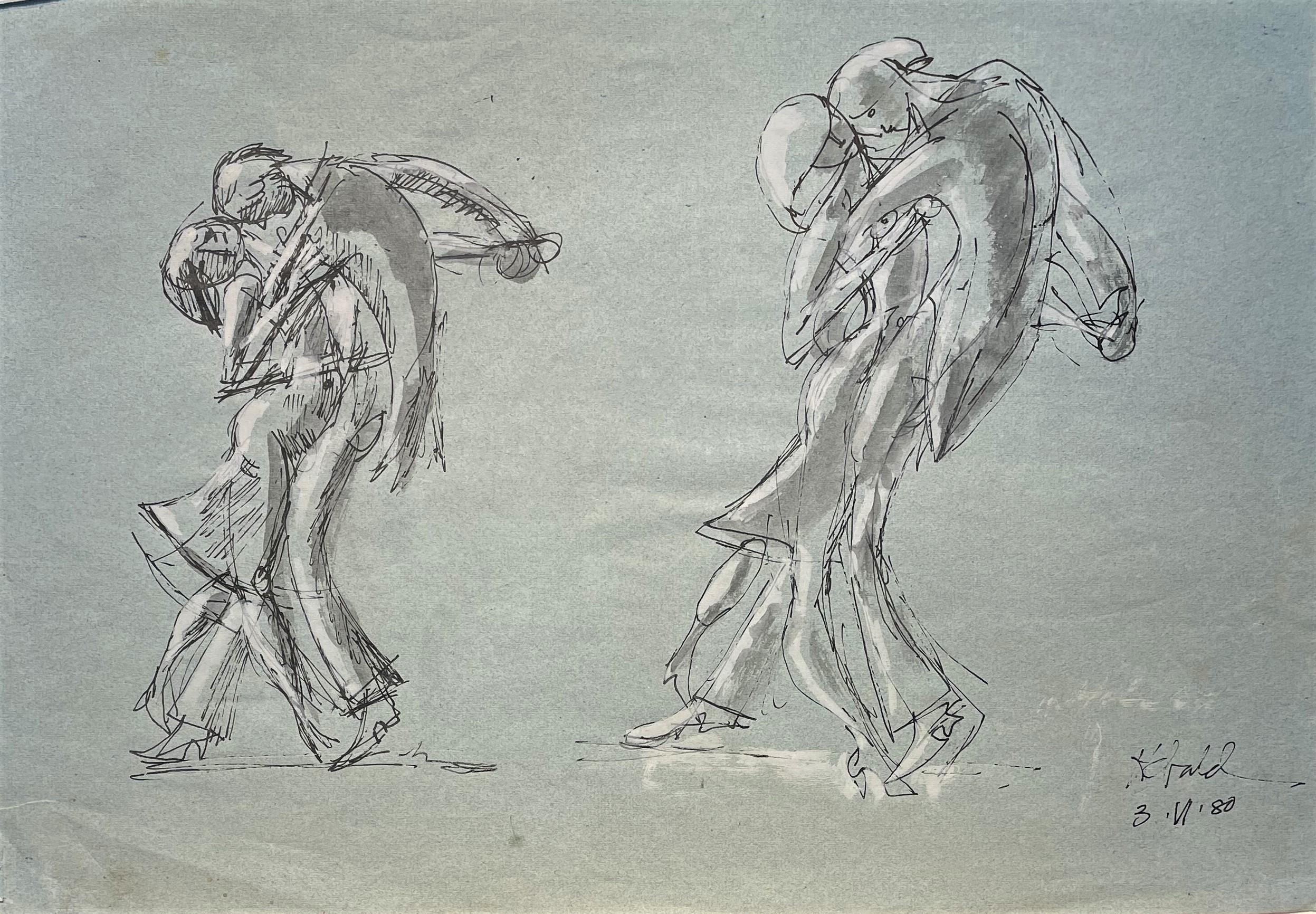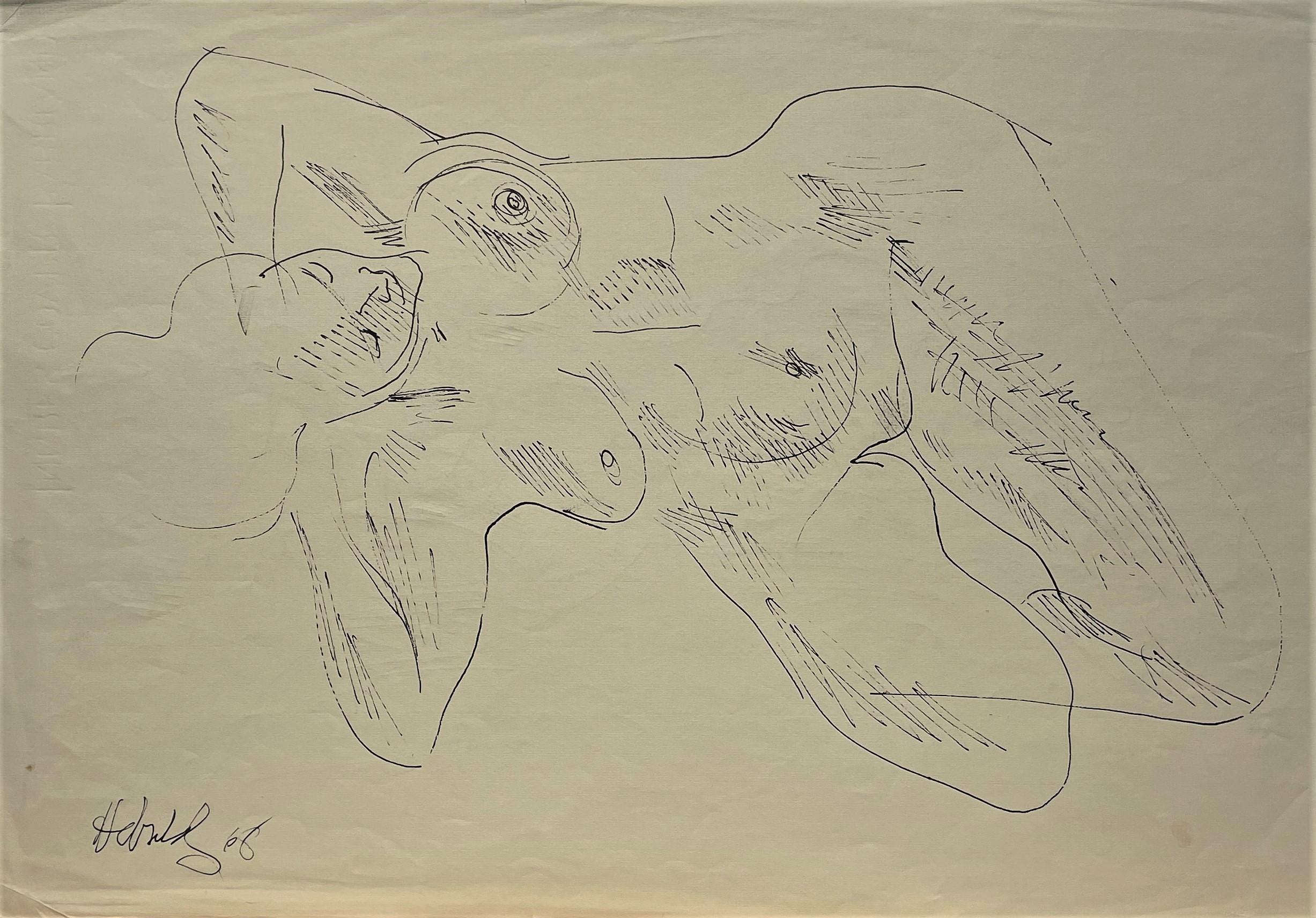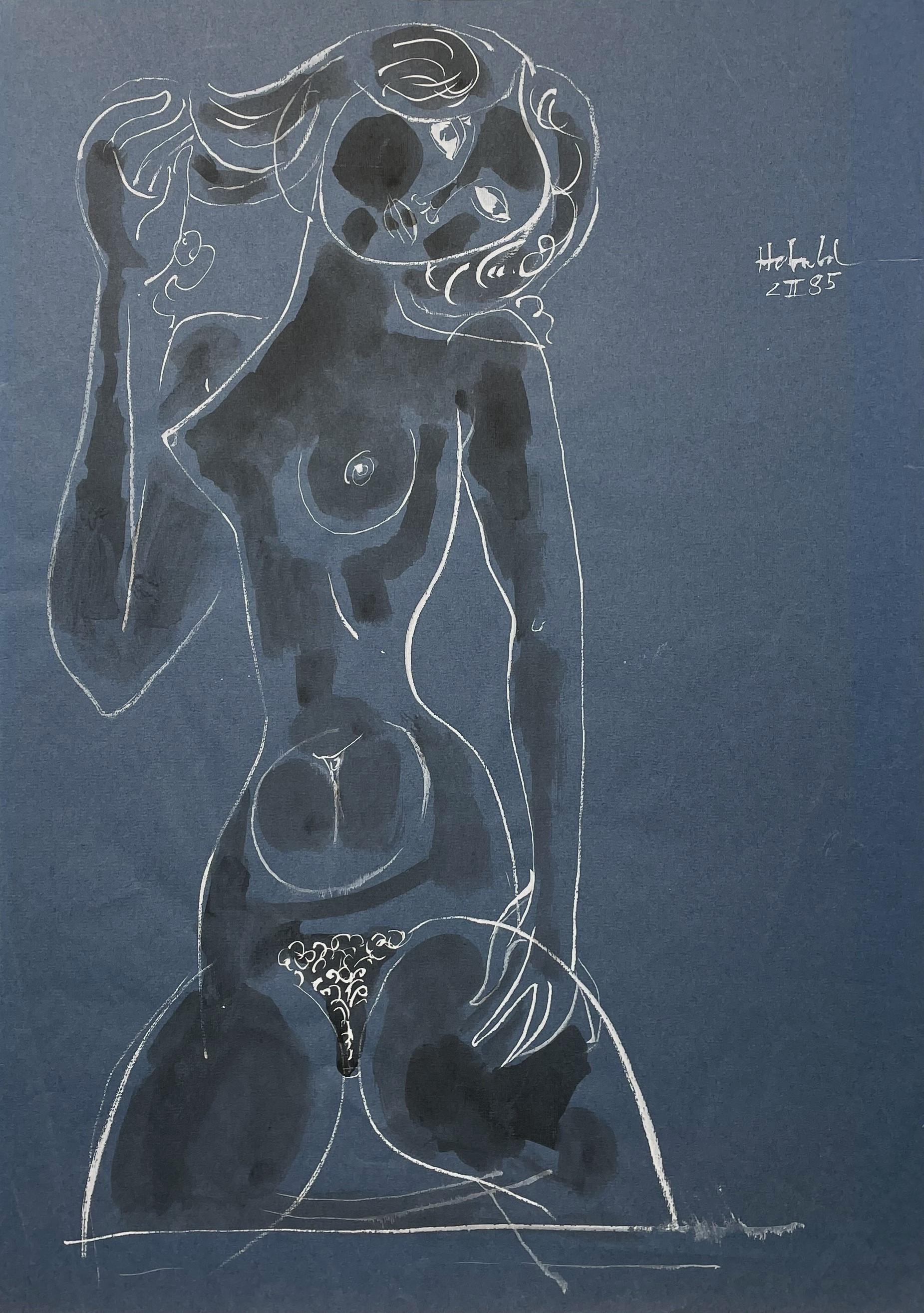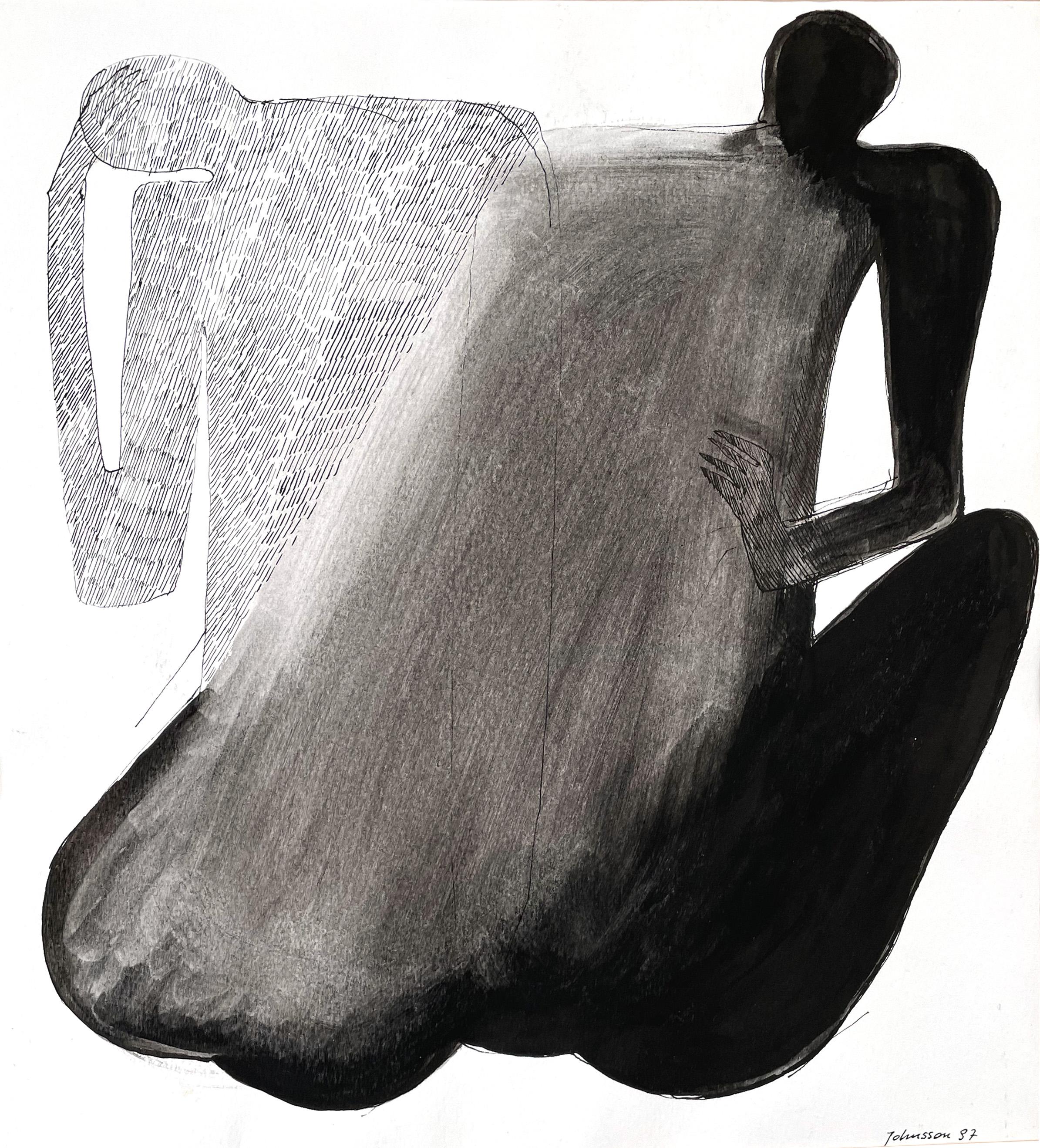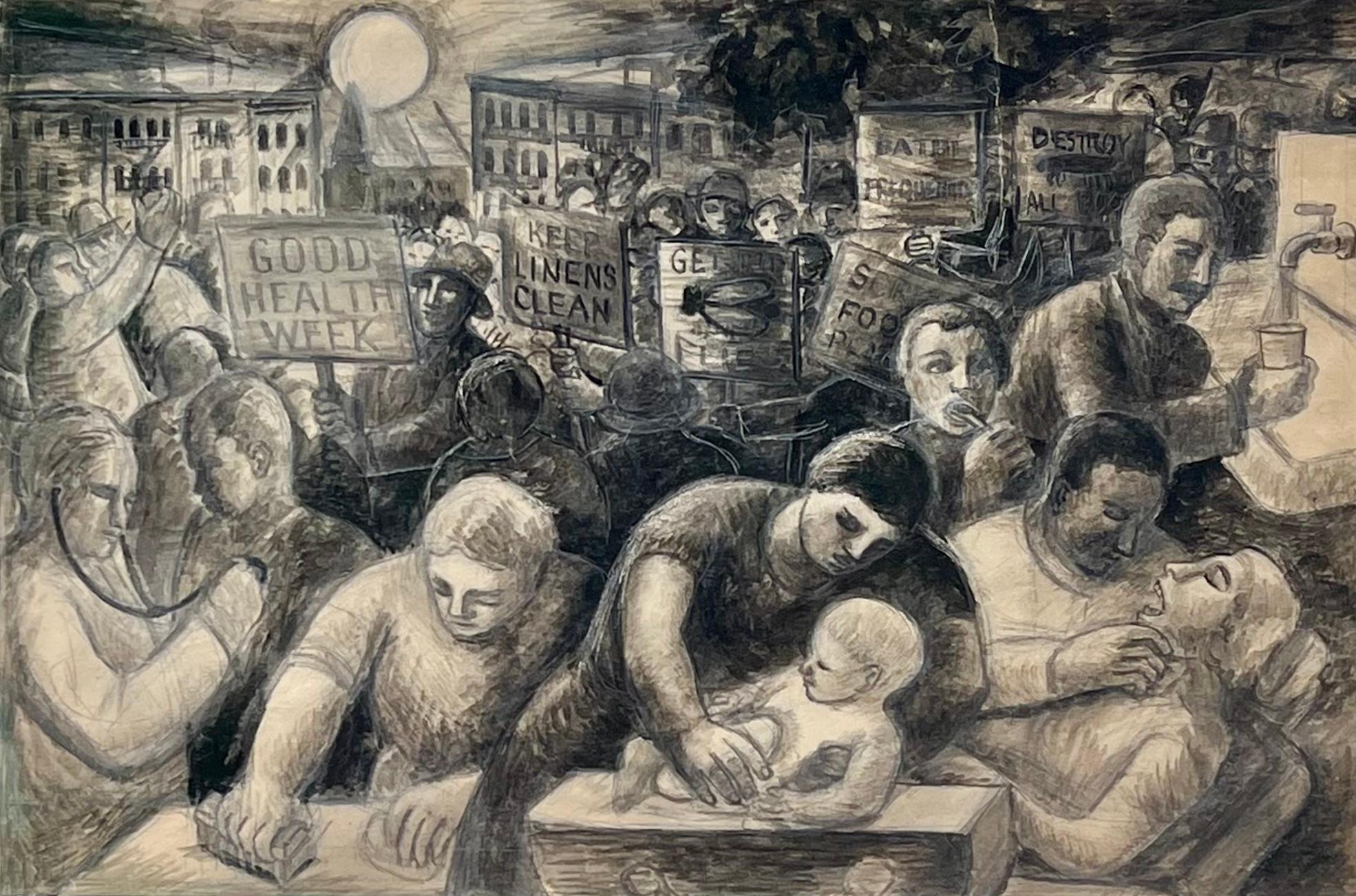Want more images or videos?
Request additional images or videos from the seller
1 of 6
Abraham WalkowitzModernist Drawing, Portrait of a Man1900
1900
About the Item
Abraham Walkowitz (March 28, 1878 - January 27, 1965) was an American painter grouped in with early American Modernists working in the Modernist style.
Walkowitz was born in Tyumen, Siberia to Jewish parents. He emigrated with his mother to the United States in his early childhood. He studied at the National Academy of Design in New York City and the Académie Julian in Paris under Jean-Paul Laurens. Walkowitz and his contemporaries later gravitated around photographer Alfred Stieglitz's 291 Gallery, originally titled the Little Galleries of the Photo-Secession, where the forerunners of modern art in America gathered and where many European artists were first exhibited in the United States. During the 291 years, Walkowitz worked closely with Stieglitz as well as Arthur Dove, Marsden Hartley, and John Marin (often referred to as "The Stieglitz Quartet").
Early Career and Training
Portrait of Abraham Walkowitz - 1907 - Max Weber - Brooklyn Museum
Walkowitz was drawn to art from childhood. In a 1958 oral interview with Abram Lerner, he recalled: "When I was a kid, about five years old, I used to draw with chalk, all over the floors and everything... I suppose it's in me. I remember myself as a little boy, of three or four, taking chalk and made drawings."[1] In early adulthood, he worked as a sign painter and began making sketches of immigrants in New York's Jewish ghetto where he lived with his mother. He continued to pursue his formal training, and with funds from a friend traveled to Europe in 1906 to attend the Académie Julian. Through introductions made by Max Weber, it was here that he met Isadora Duncan in Auguste Rodin's studio, the modern American dancer who had captured the attention of the avant-garde. Walkowitz went on to produce more than 5,000 drawings of Duncan.
Walkowitz' approach to art during these years stemmed from European modernist ideas of abstraction, which were slowly infiltrating the American art psyche at the turn of the century. Like so many artists of the time, Walkowitz was profoundly influenced by the 1907 memorial exhibition of Cézanne's work in Paris at the Salon d'Automne. Artist Alfred Werner recalled that Walkowitz found Cézanne's pictures to be "simple and intensely human experiences."[2] Working alongside other Stieglitz-supported American modernists, Walkowitz refined his style as an artist and produced various abstract works.
Walkowitz first exhibited at the 291 in 1911 after being introduced to Stieglitz through Hartley, and stayed with the gallery until 1917. During the 291 years, the climate for modern art in America was harsh. Until the pivotal Armory Show of 1913 had occurred which Walkowitz was involved with and exhibited in, modern artists importing radical ideas from Europe were received with hostile criticism and a lack of patronage.
Isadora Duncan Drawings
In 1927, Isadora Duncan echoed the lines of Walt Whitman in her essay I See America Dancing, writing, "When I read this poem of Whitman’s I Hear America Singing I, too, had a Vision: the Vision of America dancing a dance that would be the worthy expression of the song Walt heard when he heard America singing."[4] Duncan was the quintessence of modernism, shedding the rigid shackles of the balletic form and exploring movement through a combination of classical sculpture and her own inner sources. She described this search: "I spent long days and nights in the studio seeking that dance which might be the divine expression of the human spirit through the body’s movement." For Duncan, dance was a distinctly personal expression of beauty through movement, and she maintained that the ability to produce such movement was inherently contained within the body.
Abraham Walkowitz was one of many artists captivated by this new form of movement. The Duncan drawings can be interpreted as representations of Walkowitz’s loftiest goals. Composing thousands of these drawings would prove to be one of the most effective outlets for his artistic agenda due to the similarities between the artistic ideals and preferred aesthetic shared by Walkowitz and Duncan. He was also able to draw from the same subject repeatedly and extract a different experience with each observation. Sculptors most readily recognized this trait in Duncan; there was a particular quality of her dance which appeared readily artistic, yet not static. Dance critic Walter Terry described it in 1963 as, "Although her dance inarguably sprang from her inner sources and resources of motor power and emotional drive, the overt aspects of her dance were clearly colored by Greek art and the sculptor’s concept of the body in arrested gesture promising further action. These influences may be seen clearly in photographs of her and in the art works she inspired."
Isadora Duncan #29, c. 1915
In each drawing, a new observation is recorded from the same subject. In the Foreword to A Demonstration of Objective, Abstract, and Non-Objective Art, Walkowitz wrote in 1913, "I do not avoid objectivity nor seek subjectivity, but try to find an equivalent for whatever is the effect of my relation to a thing, or to a part of a thing, or to an afterthought of it. I am seeking to attune my art to what I feel to be the keynote of an experience." The relaxed fluidity of his action drawings represent Duncan as subject, but ultimately reconceive the unbound movement of her dance and translates the ideas into line and shape, ending with a completely new composition.
His interest in recording the "keynote" of experience rather than producing an objective representation of a subject is central to the composition of the Duncan drawings. The fluidity of the lines function simultaneously as recognizable shapes of the human body, but also trace the pathways of the dancer’s movements. Duncan herself wrote in 1920, "...there are those who convert the body into a luminous fluidity, surrendering it to the inspiration of the soul."[4] Placed into a different context, this passage could function as a description of Walkowitz’s art; it is in fact taken from her essay The Philosopher’s Stone of Dancing wherein she discusses techniques to most effectively express the purest form of movement.
Walkowitz’s dedication to Duncan as a subject extended well past her untimely death in 1927. The works reveal shared convictions toward modernism and breaking links with the past. In 1958, Walkowitz told Lerner, "She (Duncan) had no laws. She did not dance according to the rules. She created. Her body was music. It was a body electric, like Walt Whitman. His body electrics. One of our greatest men, America's greatest, is Walt Whitman. Leaves of Grass is to me the Bible."
Significance in Art History
While never attaining the same level of fame as his contemporaries, Walkowitz' close relationship with the 291 Gallery and Alfred Stieglitz placed him at the center of the modernist movement. His early abstract cityscapes and collection of over 5,000 drawings of Isadora Duncan also remain significant art historical records.
- Creator:Abraham Walkowitz (1878 - 1965, American)
- Creation Year:1900
- Dimensions:Height: 16 in (40.64 cm)Width: 13 in (33.02 cm)
- Medium:
- Movement & Style:
- Period:
- Condition:Measurements include frame.
- Gallery Location:Surfside, FL
- Reference Number:1stDibs: LU38211635602
About the Seller
4.9
Platinum Seller
These expertly vetted sellers are 1stDibs' most experienced sellers and are rated highest by our customers.
Established in 1995
1stDibs seller since 2014
1,546 sales on 1stDibs
Typical response time: 1 hour
- ShippingRetrieving quote...Ships From: Surfside, FL
- Return PolicyA return for this item may be initiated within 3 days of delivery.
More From This SellerView All
- Ink Drawing Man in Suit and Hat with NudeBy Jonathan ShahnLocated in Surfside, FLProvenance: Hinckley & Brohel Gallery Jonathan Shahn, Born 1938 has been making sculpture, drawings and prints of the human figure since the early 1960s. He teaches at the Art Studen...Category
20th Century American Modern Figurative Drawings and Watercolors
MaterialsPaper, Ink
- Figures in the Forest, Rare Drawing, Israeli Modernist masterBy Itzhak DanzigerLocated in Surfside, FLYitzhak Danziger Genre: Expressionist Subject: People Medium: Ink Surface: Paper Dimensions w/Frame: 17" x 17" Yitzhak Danziger (Hebrew: יצחק דנציגר; 26 June 1916 – 11 July 1977) was an Israeli sculptor. He was one of the pioneer sculptors of the Canaanite Movement, and later joined the "Ofakim Hadashim" (New Horizons) group. orn in Berlin in 1916, Izhak Danziger moved to Palestine in 1923. From 1934-1937 Danziger studied at the Slade School of Fine Art, London. During the 1940s he worked in Paris with Zadkine and Brancusi. In the 1950s he exhibited in London at the Institute of Contemporary Art. He is considered to be one of Israel's most important sculptors. His work, which consists largely of environmental pieces, has been exhibited at the Hisrshhorn Museum and Sculpture Garden in Washington D.C. In 1969 Danziger was awarded the Sandberg Prize by the Israel museum. He died in 1977. When discussing Chariot II, Mordechai Omer compares it to a work of similar subject by Alberto Giacometti. He explains that Danziger, unlike Giacometti, removes the figure, leaving only the chariot itself. Omer eloquently explains that "The vehicle designed to serve the needs of the person inside is devoid of this human presence, with only the memories of its headlong downhill journeys leaving their mark in the parts of a half-ruined, half-standing chariot, allowing wide scope for the viewer's imagination. If Giacometti's chariots reminded him of hospital pharmacy wagons, Danziger's gleaming brass chariots...Category
Mid-20th Century Modern Figurative Drawings and Watercolors
MaterialsPaper, Ink
- Vintage Israeli Bezalel School Drawing Family Playing, Dogs Puppies Kibbutz LifeBy Moshe AvniLocated in Surfside, FLMoshe Avni was born in 1937, in Kibbutz Kfar Blum in the Upper Galilee in Israel. Presently, he lives and paints in Jerusalem. During the years 1956-1957, he studied Painting and Graphic Arts in the Bezalel Art School in Jerusalem, supported by a Betzalel School Scholarship. He studied with and was guided by the painter Leo Roth, z”l (1914-2002), from Kibbutz Afikim. Moshe Avni has participated in Workshops and Courses in the framework of the Kibbutz Movement and the Israeli Artists’ Organization. He has received scholarships from both the Sharett Fund and from the Norman Fund. In 1979, Moshe Avni was accepted to the Israeli Artists’ Organization. Exhibitions 2011 In the Jerusalem House of Quality – 16-22 December 2011 2009 In the Neighborhood Center of Beit haKerem, Jerusalem 2003 In Moshav Batzra, Israel 1984 In the Artists’ Quarter, Rishon leZion, Israel 1979 In the House of Culture for Young People, Kfar Saba, Israel 1977 In the “New Gallery”, Tel Aviv, Israel 1973 In the “New Gallery”, Tel Aviv, Israel 1970 In “The House of Uri and Rami Nechushtan” in Ashdot Yaacov, Israel Horses & People, New Gallery, Tel Aviv 1965 Journalists House - Sokolov House, Tel Aviv, Israel Exhibitions of Young Artists in “House of Helena Rubenstein”, Tel Aviv, Israel Private Exhibitions in Jerusalem, Tel Aviv, and more. Group Exhibitions Kiryat Shmona 1957 Artists: Noemi Schindler...Category
1960s Modern Figurative Drawings and Watercolors
MaterialsPen, Paper, Ink
- Large Drawing of Boy by French Armenian Modernist Jean Jansem Ecole De Paris ArtBy Jean JansemLocated in Surfside, FLJean Jansem (Hovhannes Semerdjian) 1920-2013 Young Boy (sad young man) Hand signed lower left corner Provenance: Marble Arch Gallery NYC Measurements Image size: 25 by 18 inches, ove...Category
1960s Modern Figurative Drawings and Watercolors
MaterialsPaper, Ink
- Americana, Lawyer in Court, Politician, Gouache Painting WPA Art William GropperBy William GropperLocated in Surfside, FLWilliam Gropper Original Gouache on Paper Hand signed lower right 33.5 x 27.5 image 26 x 20.5 The New-York born artist William Gropper was a painter and cartoonist who, with caricature style, focused on social concerns, and was actively engaged in support of the organized labor movement throughout his career. This original watercolor drawing is done in the iconic style of the artist's oeuvre. Born to Harry and Jenny Gropper in 1897, William was raised in New York City's Lower East Side. His parents were Jewish immigrants from Romania and Ukraine, and young William grew up in relative poverty, watching his family struggle to achieve that sought-after American dream. His father, a bright and college-educated man, was unable to find employment that worthy of his intellect. His mother, meanwhile, worked as a seamstress from home. Coupled with the devastating loss of an aunt to the infamous Triangle Factory fire of 1911, significant childhood factors created the foundation that led to Gropper’s exploration of the American experience. Early on, Gropper displayed an extraordinary, natural skill for art. By 1912, he was already studying under the instruction of George Bellows and Robert Henri at the Ferrer School in Greenwich Village. During his time at school, Gropper was also awarded a prestigious scholarship to study at the National Academy of Design. However, he refused to fit into convention and was swiftly expelled from the Academy. After his expulsion, Gropper returned home to help financially by assisting his mother and taking a shop position. However, he didn't abandon art academia and soon presented a portfolio to the New York School of Fine Art which earned him a scholarship for study. Gropper obtained his first significant job as a cartoonist for the New York Tribune in 1917. While working as a staff cartoonist for the Tribune, he also contributed drawings to publications like Vanity Fair, New Masses, The Nation, and Freiheit. His interest in the welfare of the American worker, class inequality, and social injustice was central in his work. After publishing the graphic novel Alley Oop in 1930, Gropper's illustration career extended well into the decade. However, he was never exempt from controversy, and his 1935 Vanity Fair cartoon; prompted anger from the Japanese government. As an involved labor organizer and Social Realist activist, Gropper continued to bring attention to his radical reputation with visits to the Soviet Union and Poland. However, his concern with European politics and U.S. social causes didn't slow down his artistic career, and by the late 1930s, he had produced significant murals for American cities like Washington D.C. His 1938 mural Construction of a Dam was commissioned for the Department of the Interior and represents the Social-Realism style that depicts experiences of the worker and everyday societal life. Measuring at a staggering 27ft by 87ft, the piece portrays muscular, robust American laborers scaling rocky hillsides, building infrastructure, and operating heavy machinery. The mural feels undeniably American with golden scenery, denim blues, and steely gray colors. Gropper fits perfectly into Social-Realism because the style exhibits an illustrative flair with strong lines and simple, bold hues. The inspiration for Construction of a Dam sprang from his 1937 travels to the poverty-stricken Dust Bowl area. The trip was sponsored by a Guggenheim Foundation Fellowship, and his drawings of the Grand Coulee and Boulder Dams...Category
Mid-20th Century Modern Figurative Paintings
MaterialsInk, Watercolor, Gouache
- Whimsical Illustration "Snow" Cartoon, 1938 Mt Tremblant Ski Lodge William SteigBy William Steig (b.1907)Located in Surfside, FLLighthearted Illustration of Outdoor Pursuits This one being cross country Snow Shoes signed "W. Steig" Provenance: from Mrs. Joseph B. Ryan, Commissioned by ...Category
1930s American Modern Figurative Drawings and Watercolors
MaterialsIndia Ink, Watercolor, Illustration Board
You May Also Like
- Lindy Hop StudyLocated in Santa Fe, NMA wonderful pen and ink study of entwined dancers by Milton Hebald, beautifully executed on a lovely grey Italian rag paper. Hebald is regarded as one of the most important American figurative...Category
Late 20th Century American Modern Figurative Drawings and Watercolors
MaterialsPaper, Ink, Tempera
- Dancers StudyLocated in Santa Fe, NMA wonderful pen and ink study of entwined dancers by Milton Hebald, beautifully executed on a lovely grey Italian rag paper. Hebald is regarded as one of the most important American figurative...Category
Late 20th Century American Modern Figurative Drawings and Watercolors
MaterialsPaper, Ink, Tempera
- AntonellaLocated in Santa Fe, NMA rare Ink on Paper nude figure drawing by Milton Hebald. It is especially unique as both side of the paper have fully resolved drawings of the same subject, 'Antonella'. Hebald is regarded as one of the most important American figurative sculptors...Category
Late 20th Century American Modern Nude Drawings and Watercolors
MaterialsPaper, Ink
- Nude GirlLocated in Santa Fe, NMA rare Ink on Paper nude figure drawing by Milton Hebald, beautifully executed on a lovely blue Italian rag paper. Given the stylization, it is likely a study for one of his sculptures. Hebald is regarded as one of the most important American figurative sculptors...Category
Late 20th Century American Modern Nude Drawings and Watercolors
MaterialsInk, Tempera, Paper
- Two in OneBy Jolanta JohnssonLocated in Boxholm, SEJolanta Johnsson, experienced Polish artist, graduate of the Academy of Fine Arts in Warsaw, PhD of fine arts, university teacher. She currently lives in Sweden. This is how she writ...Category
21st Century and Contemporary Modern Figurative Drawings and Watercolors
MaterialsInk, Paper
- "Good Health Week" American Scene Modern Social Realism Double Sided WPA EraBy Jo CainLocated in New York, NY"Good Health Week" American Scene Modern Social Realism Double Sided WPA Era Jo Cain (1904 - 2003) Good Health Week – double sided 13 3/4 x 20 1/2 in...Category
1930s American Modern Figurative Drawings and Watercolors
MaterialsGouache, Paper, Ink
